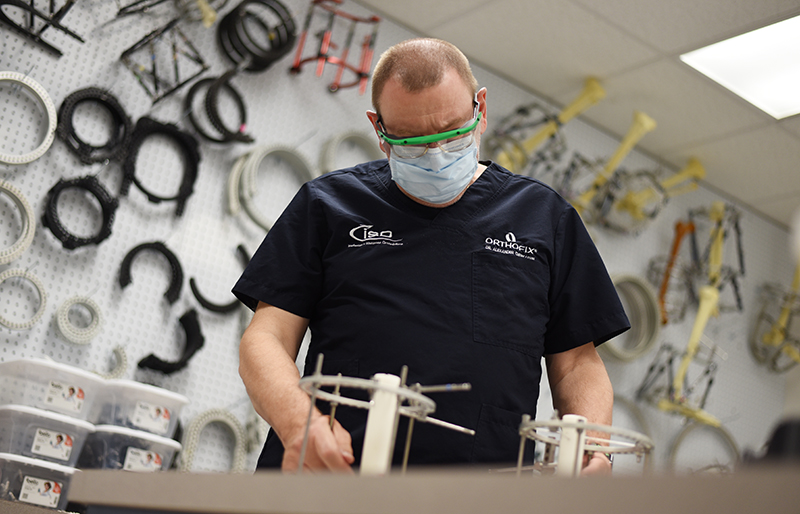Applied Research

Bioengineering and Biomechanics Division
The department’s efforts have led to more than 16 U.S. patents and significant developments, such as the TSRH® Spinal System and TRUE/LOK™ External Fixation System. Our small but dedicated staff has played a major role in setting the standard for modern orthopedic care.
Applied Science
The applied science group works closely with researchers and clinicians to develop new treatment methodologies and improved hardware solutions in pediatric orthopedics. The team’s objective is to find innovative ways to utilize the groundbreaking work of our scientific researchers and transition it to our patient population. One way this is done is by evaluating research discoveries and focusing on their implementation. Another way of effecting this transition is to evaluate potential new treatment techniques for safety and efficacy.
Applied science utilizes a broad range of skills and tools to aid our researchers and clinicians in reaching their objectives. Anatomical analysis and reconstruction are used to aid our clinicians in surgical planning and evaluating pediatric-specific conditions. Biomechanical principles are utilized to evaluate proposed treatment options and techniques. Finally, product development is a key component in bringing basic science research forward into a clinical setting.
Anatomical Analysis and Reconstruction
The Scottish Rite for Children applied research team aids our physicians in surgical planning by taking advanced imagery and recreating full-scale surgical models that can be used to determine surgical approaches and unique anatomical features and aid in explaining to our patient families the various treatments that our patients will be undergoing.
Once a magnetic resonance imaging (MRI) or computed tomography (CT) image has been taken, we use cutting-edge software to create a fully digital 3D image. This image is further processed using 3D design software to create a model file, which is then used to create a full-scale, 3D-printed model.
In a research capacity, these same technologies are used to evaluate the before and after effects of various medical treatments commonly used at Scottish Rite to better aid our physicians in providing the best treatment available for our patients.
Publications:
- Can We Estimate the Amount of Malrotation in Supracondylar Humerus Fractures After CRPP? - PubMed (nih.gov)
- 3D MRI Quantification of Femoral Head Deformity in Legg-Calvé-Perthes Disease - PubMed (nih.gov)
- The point of epiphyseal penetration affects rotational stability of screw fixation in slipped capital femoral epiphysis: A biomechanical study - PubMed (nih.gov)
Biomechanics
The bioengineers at Scottish Rite for Children evaluate the effectiveness of various surgical interventions using in-house material testing machines coupled with motion capture analysis. In this manner, the effects of applied loads can be evaluated across complex anatomy.
These tools have enabled our physicians to evaluate the effectiveness of newly proposed surgical techniques in the treatment of trauma, clubfoot disorders, sports medicine, foot and ankle, and other orthopedic diseases and injuries.
The material testing machines are also used to recreate in-vitro disease models, which are important tools in evaluating prospective treatments. Depending on the nature of the disease, models can be created using quasi-static methods or high-frequency and high-cycle count fatigue models.
Material testing machines can then be used to evaluated the safety and effectivity of the proposed treatments after application.
Publications:
- Reverse Dynamization Accelerates Bone-Healing in a Large-Animal Osteotomy Model - PubMed (nih.gov)
- Biomechanical Analysis of Retrograde Flexible Intramedullary Nail Constructs in a Simulated Pediatric Femur Fracture Model - PubMed (nih.gov)
- Do We Really Need to Worry About Calcaneocuboid Subluxation During Lateral Column Lengthening for Planovalgus Foot Deformity? - PubMed (nih.gov)
Product Development
The bioengineering group works closely with our team of researchers and physicians to come up with solutions to difficult pediatric orthopedic conditions. Our researchers have developed over 35 patents aimed at treating a variety of orthopedic conditions such as scoliosis (Halo gravity traction), limb lengthening and reconstruction (Ilizarov technology), growth modulation and Perthes disease.
Concepts are developed using 3D design software (CAD) and analyzed using finite element analysis (FEA). Prototypes are first evaluated using 3D printing (plastic) before metal prototypes are made in-house using components that can be evaluated at a functional level.
Benchtop and mechanical testing are used to further improve the designs for future use and ensure safety and efficacy of the devices being developed.

Major Findings & Innovations
At Scottish Rite for Children, our researchers are committed to discovering new treatment techniques, making sure our patients receive the latest and most innovative care.
Learn more about Scottish Rite’s innovations throughout the decades.
